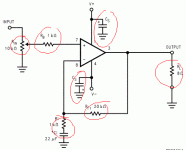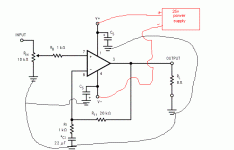I just recieved two LM3875T's today and I really want to test one out but I a bit short on resistors and capacitors. I've attached a schematic with some stuff circled and I was wondering if it's absolutely necessary to include them in this schematic or if I should buy everything I need before I attempt anything.
Thanks 🙂
Thanks 🙂
Attachments
Rin is a volume control
Rb is to reduce DC offset
Cs is supply filtering
Rfi and Ri are gain setting resistors and Rfi/Ri > 10
Ci is to reduce DC offset
Rb is to reduce DC offset
Cs is supply filtering
Rfi and Ri are gain setting resistors and Rfi/Ri > 10
Ci is to reduce DC offset
MC said:I just recieved two LM3875T's today and I really want to test one out but I a bit short on resistors and capacitors. I've attached a schematic with some stuff circled and I was wondering if it's absolutely necessary to include them in this schematic or if I should buy everything I need before I attempt anything.
Thanks 🙂
C1 not needed and RL is your speaker. The rest of them, unfortunatley ablolutely have to be there.
you could exclude the volume control if you are able to run the amp from the headphone socket of something....
Rfi and Ri are to determine voltage gain. Its OK! But What Ci makes? If we ommit that what happens?
In the UK, the first day of April is called April Fools day when people play a lot of silly pranks. Reading some of the posts here this morning it looks as though the last day of December is the equivalent in the US! 😱
If you replace it with a short circuit then the amp will have flat response down to DC. Normally you would want to reduce the gain to 1 below a few Hz.Dxvideo said:But What Ci makes? If we ommit that what happens?
Edit: I have left off RB before with no obvious problem.
Circlotron said:If you replace it with a short circuit then the amp will have flat response down to DC. Normally you would want to reduce the gain to 1 below a few Hz.
Edit: I have left off RB before with no obvious problem.
You will have quite a DC offset if you short Rb and short C1 at the same time. If C1 is there, Rb is not that critical.
leaving off Rb and Ci will likely increase the "DC-offset." DC offset means the output of the amplifer is shifted up by a constant voltage. this causes turn on and turn off pops. people usually try for less then 100mV of DC offset, with a trend being a goal of less then 10mV. adding Rb and Ci are supposed to help lower this value. the only issue with Rb is that it is in series with the lower half of the potentiometer. most designs seem to leave it out -- after all if you change the volume you would also change what Rb should be...
i've made an amplifer without Rb or Ci. there is DC offset, but as i recall it was just a nuisence for the turn on turn off pop.
i've made an amplifer without Rb or Ci. there is DC offset, but as i recall it was just a nuisence for the turn on turn off pop.
aiight, so I think I'll go out and buy the rest of the componets today but what should the value for Cs be?
Why not buy them all? Lower quality resistors/caps shouldn't cost you more than $10 anyway.
And, as i was explained, if you omit the volume pot, you should replace it with a resistor so to avoid troubles if you ever power the amp up w/o hooking up a source to it (especially while having speakers hooked up). I ommited the pot, didn't put a resistor in place, and have no problems. Well, that is until the source was disconnected from the amp. Some not so nice sounds came out of my speakers!
And, as i was explained, if you omit the volume pot, you should replace it with a resistor so to avoid troubles if you ever power the amp up w/o hooking up a source to it (especially while having speakers hooked up). I ommited the pot, didn't put a resistor in place, and have no problems. Well, that is until the source was disconnected from the amp. Some not so nice sounds came out of my speakers!
for now I think I'll use this variable power supply I have (5-30 volts) but eventually I'll build a dedicated power supply circuit.
sweet 🙂
One last question for now...
Are the grounds in that circut different than v-?
edit: err.. should the polarized caps be rated at 25 volts?
One last question for now...
Are the grounds in that circut different than v-?
edit: err.. should the polarized caps be rated at 25 volts?
Yes, -V is negative with respect to ground. You need a dual rail supply: +V, 0V and -V.
The caps voltage rating should be no less than the supply voltage, ideally it should be greater.
The caps voltage rating should be no less than the supply voltage, ideally it should be greater.
- Status
- Not open for further replies.
- Home
- Amplifiers
- Chip Amps
- Would it kill me to not use these caps and resistors


